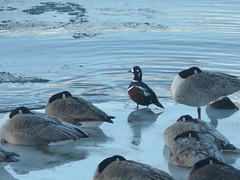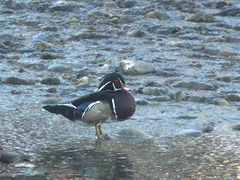Anne Elliott's photos with the keyword: Duck
Harlequin Duck male / Histrionicus histrionicus
| 19 Oct 2018 |
|
|
Yesterday afternoon, 17 October 2018, I managed to get over to Carburn Park for a walk. Though I have seen a number of Rusty Blackbirds, this species was still a bird I wanted to look out for. As it turned out, this was not one of my finds. However, I saw a few other things that were a delight to see, including meeting two Ferrets that were out for a walk (or rather, travelling in a stroller) with their 'people". Both are rescue animals, which was good to see.
"Ferret Rescue & Education Society (FRES) is a non-profit, charitable organization that was started by a group of devoted ferret owners in the Calgary area who recognized the need for a locally based rescue dedicated to ferrets. Our committed volunteers assist FRES in their goal to find permanent homes for all of the ferrets surrendered to us. They also provide shelter, basic needs, veterinary care, and if necessary, rehabilitation for all abused, unwanted, and abandoned ferrets regardless of their health status." From the FRES website.
www.ferrets.ca/
Another lovely encounter was with the resident Great Horned Owl. Two friends that I bumped into in the park described where they had just seen it. Two or three strangers also helped pinpoint the exact tree : ) Over the years, we have seen Great Horned Owls in this park - always a joy. Yesterday, this owl was rather agitated and moved two or three times. One of the park's Eastern Gray Squirrels was teasing the owl.
As if a couple of Ferrets and a Great Horned Owl weren't enough, we were also very lucky to see a Harlequin Duck (male) out on the Bow River. When we first saw it, it wasn't too far out on the water, but it gradually swam further and further away, diving constantly. Not the greatest photos, but they serve as a record of seeing this very handsome duck.
The weather was gorgeous, and much-deserved after the dreadful winter weather we have been having (in fall)! A perfect day to be outdoors, so I just couldn't resist. Lovely to see you, Pam, though unfortunate that you were just leaving when I arrived. Great to see you, Bonnie, and spend time with you. Has been a long time, no see.
Commonly beautiful
| 20 Mar 2008 |
|
I usually take a few shots of the Mallards that visit the Zoo when I go there. On a sunny day, the iridescense is gorgeous.
Bottoms up
| 20 Nov 2007 |
|
Sometimes, you just have to take a photo of a duck like this, especially when there are so many tiny water droplets all over the feathers. Who can resist those brilliant orange legs and feet?
The new mother
| 16 May 2008 |
|
This Mallard and her mate have made a stretch of open water at the Calgary Zoo their home. These were the tiniest ducklings I think I have ever seen!
Mr. and Mrs. Wood Duck
| 05 Oct 2008 |
|
Not sure how many Wood Ducks we ended up seeing at the Inglewood Bird Sanctuary this morning, but I think it was around 30 (actually, 32)! Usually, this species is at the far side of a river or pond, but today there were three sitting on a log much closer to where we were walking. The male (on the right) is quite a spectacular bird and the female has some interesting colours and patterns, too. Never seen this many before!
4 x 2 = 8
| 08 Sep 2012 |
|
Wood Ducks love to sit on this tree trunk that slopes down into the lagoon at Inglewood Bird Sanctuary. Unfortunately, you can't get close, so this is a very distant and heavily cropped shot.
Barrow's Goldeneye / Bucephala islandica
| 14 Dec 2010 |
|
A very distant and and "cropped to almost nothing" shot of two male Barrow's Goldeneye : ) Normally, I don't bother to try and get a photo of this species because the ducks are always on the far side of the Bow River. However, last Saturday, on a walk at Carburn Park, these were just out from the far bank. I don't have a photo of this species in my Birds of Alberta Set, so wanted to add this one. Just something else for those of you who are not birders - watch out for these white crescents : )
Mallard pose
| 04 May 2010 |
|
She's beautiful, even if she is "just" an everyday female Mallard : ) I never get tired of photographing Mallards, or seeing photos taken by other photographers.
Northern Shoveler pair
| 19 Jan 2010 |
|
A photo from my archives (15th June last year) - a pair of Northern Shovelers seen in the area south east of Calgary, near where the Red Foxes had their den.
talkaboutwildlife.ca/profile/?s=37
Long-tailed Duck
| 23 Oct 2009 |
|
A very distant and heavily cropped image of this Long-tailed Duck, first winter male. An exciting bird to see - we were very lucky for this chance when we were on a walk by the Glenmore Reservoir three days ao!
"The Long-tailed Duck, formerly known as the Oldsquaw, breeds across the Alaskan and Canadian Arctic, and spends the winter on the Pacific Ocean. Consequently, it is only a rare transient through Alberta.
A very few Long-tailed Ducks appear in Alberta in late October and early November. Very occasionally, one will overwinter on an open river or lake in the province. They are even scarcer on spring migration from March to May." Written by Andrew Slater for talkaboutwildlife.ca/profile/index.php?s=47 .
Looking good
| 14 Nov 2009 |
|
I'm not seeing all that many birds recently, and those that I do see are very distant. So, the other morning, I photographed a Mallard : ) At least SHE came close enough, LOL. Thought she looked pretty in the sunlight and with her reflection. Seen down at Carburn Park.
(Extra)ordinary details
| 16 Jan 2009 |
|
I never tire of seeing and photographing Mallards, both male and female. This female was lying on the snow at the Calgary Zoo.
Swimming in liquid gold
| 01 Nov 2008 |
|
A gorgeous, male Wood Duck, swimming on the Elbow River this morning at Stanley Park (Calgary, not Vancouver). A very heavily cropped photo, as the duck was out in the middle of the river! We had a very enjoyable three-hour walk on this beautiful fall day. So glad I went, as when I checked the long-range forecast for the city last night, there was a tiny snowflake graphic on about six days in a row for the week after next. Of course, the forecast could change by then.
Female beauty
| 19 Jul 2008 |
|
This beautiful female posed for me when I came across this slough on a drive south of Highway 22X yesterday. However, can anyone tell me if this is a female Mallard or a female of a different species? Would appreciate any help - thanks!
Northern Shoveler
| 23 May 2008 |
|
Northern Shovelers are common in Alberta from March to September. Photographed this male south east of Calgary, in the Frank Lake area.
"This species is unmistakable in the northern hemisphere due to its large spatulate bill. The breeding male has a green head, white breast and chestnut belly and flanks. In flight, pale blue forewing feathers are revealed, separated from the green speculum by a white border.
The females are light brown, with plumage much like a female Mallard, but their long broad bill easily identifies them. The female's forewing is grey. In non-breeding (eclipse) plumage, the drake looks more like the female.
It is a bird of open wetlands, such as wet grassland or marshes with some emergent vegetation, and feeds by dabbling for plant food, often by swinging its bill from side to side and using the bill to strain food from the water. This bird also eats mollusks and insects in the nesting season. The nest is a shallow depression on the ground, lined with plant material and down, usually close to water." From indopedia.org.
Quack, quack
| 07 Apr 2008 |
|
Freely wandering around at the Zoo, this male Mallard gave me a chance to see inside a duck's bill.
"The mallard has what you might call a typical duck's bill. The bill isn't very long, but it's not very short, either. It's not overly wide, nor overly narrow. It's a very versatile bill because it lets the mallard eat a wide assortment of plants and animals, from microscopic plant seeds to snails and acorns.
Wildlife biologists consider mallards to be "gen-eralist feeders." That means they'll eat whatever food is available. Although mallards sometimes eat insects, plankton and even snails, more than 90 percent of a mallard's diet comes from plants, They mostly eat wetland plants, but they'll also consume land plants, including grasses and crop plants like wheat, barley, rice, oats and peanuts.
If you look closely, you can see a kind of serrated fringe along a mallard's bill. This uneven edge not only allows it to grip food more securely, but it also strains tiny plants and animals from water or mud." From mdc.mo.gov/kids/out-in/2004.
Harlequin Duck
| 12 Dec 2007 |
|
Taken in really bad light early this morning on a walk at Beaverdam Flats. However, this is the closest photo (by far!) that I have of a Harlequin Duck. They are locally uncommon here from May to September. I think I'm right in saying that there are about five of these small ducks in the city, so it's a treat to see them. Actually, there is a female mainly hidden behind the right, upper Goose. This photo doesn't show the beautiful colours of this male duck, but you can still see the patterns. The male has a grey-blue body, chestnut sides, white spots and stripes on the head, neck and flanks. In contrast, we saw about 5,000 Canada Geese along the Bow River today!
Wood Duck
| 17 Dec 2007 |
|
Saw this Wood Duck when we walked by the Elbow River yesterday morning, for the Christmas Bird Count. Highly zoomed and cropped - these birds are always too far away! Rare to uncommon in Alberta from April to October. The male Wood Duck is one of the most colourful water birds in North America. The Inglewood Bird Sanctuary is a good place to see these ducks.
Jump to top
RSS feed- Anne Elliott's latest photos with "Duck" - Photos
- ipernity © 2007-2025
- Help & Contact
|
Club news
|
About ipernity
|
History |
ipernity Club & Prices |
Guide of good conduct
Donate | Group guidelines | Privacy policy | Terms of use | Statutes | In memoria -
Facebook
Twitter


















